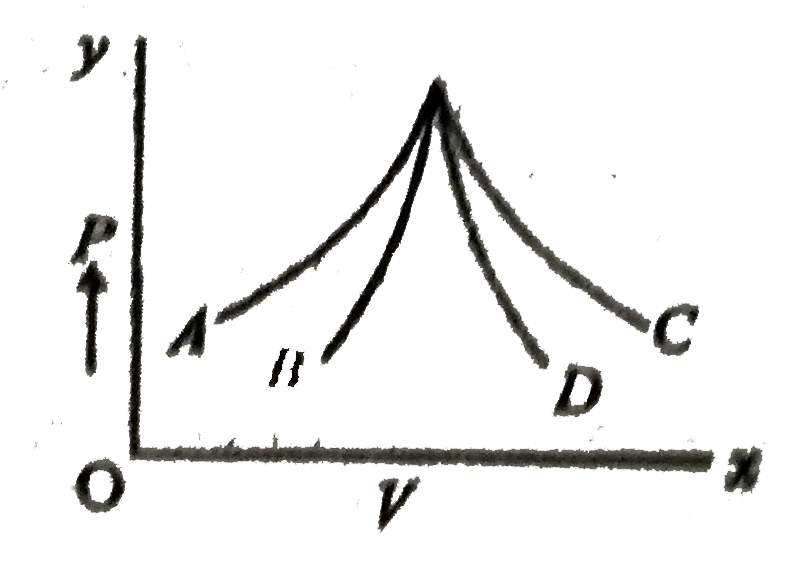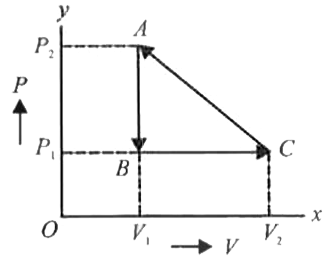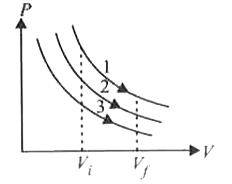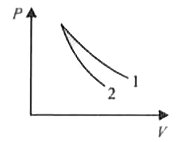Complete Solutions to WB JEE WORKOUT ( CATEGORY 1 : Single Option Correct Type (1 Mark ) of chapter THERMODYNAMICS of Class 12 book with complete answers and questions
| Class 12 | PHYSICS |
| Chapter | THERMODYNAMICS |
| MTG-WBJEE | WB JEE WORKOUT ( CATEGORY 1 : Single Option Correct Type (1 Mark ) |
| Number Of Questions | 30 |
| Academic Year | 2023-24 |
When the room temperature becomes equal to the dew point , the relative humidity of the room is
View SolutionFigure shows four PV diagrams. Which of these curves represent isothermal and adiabatic processes?
 02:02View Solution
02:02View SolutionA perfect gas goes from state A to another state B by absorbing 8 x `10^5` J of heat and doing 6.5 x `10^5` J of external work. It is now transferred between the same two states in another process in which it absorbs `10^5` J of heat. Then in the second process,
05:32View SolutionFive moles of hydrogen `(gamma = 7//5)`, initially at `STP`, is compressed adiabatically so that its temperature becomes `400^(@)C`. The increase in the internal energy of the gas in kilojules is `(R = 8.30 J//mol-K)`
01:05View SolutionA gas under constant pressure of `4.5 xx 10^(5) Pa` when subjected to `800 kJ` of heat, changes the volume from `0.5 m^(3) to 2.0 m^(3)`. The change in internal energy of the gas is
02:23View SolutionOne mole of an ideal gas requires 207 J heat to raise its temperature by 10 K when heated at constant pressure. If the same gas is heated at constant volume to raise the temperature by the same 10 K, the heat required will be (R, the gas constant = `8.3 JK^(-1) mol^(-1)`):
03:33View SolutionOne mole of ideal gas undergoes a cyclic process ACBA as shown in figure. Process AC is adiabatic. The temperatures at 1, B and C are 300 K,600 K and 450 K respectively. Choose the correct statement.
 View Solution
View SolutionAn ideal gas expands isothermally from volume `V_(1)` to `V_(2)` and is then compressed to original volume `V_(1)` adiabatically. Initialy pressure is `P_(1)` and final pressure is `P_(3)`. The total work done is `W`. Then
02:52View SolutionIn an adiabatic change, the pressure and temperature of a monoatomic gas are related as `pxxT^(C )`, where C equals
03:34View SolutionWhat is the nature of change in internal energy in the following three thermodynamical processes as shown in the given figure.
 View Solution
View SolutionOne mole of an ideal gas at temperature `T_(1)` expands according to the law (P/V) = constant. Find the work done when the final temperature becomes `T_(2)`.
View Solution`P - V` diagram of an ideal gas is as shown in figure. Work done by the gas in process `ABCD` is
 02:50View Solution
02:50View SolutionIn an isobaric process, `Delta Q = (K gamma)/(gamma - 1)` where `gamma = C_(P)//C_(V)`. What is ` K`?
01:29View SolutionTwo different ideal diatomic gases `A` and `B` are initially in the same state. `A` and `B` are then expanded to same final volume through adiabatic and isothermal process respectively. If `P_(A), P_(B)` and `T_(A), T_(B)` represents the final pressure and temperature of `A` and `B` respectively then.
01:52View SolutionWork done by the system in closed path ABCA is
 View Solution
View SolutionA monoatomic ideal gas, initially at temperature `T_1,` is enclosed in a cylinder fitted with a friction less piston. The gas is allowed to expand adiabatically to a temperature `T_2` by releasing the piston suddenly. If `L_1 and L_2` are the length of the gas column before expansion respectively, then `(T_1)/(T_2)` is given by
02:47View SolutionIn figure, three isothermal processes are shown for the same gas and for same change in volume `(V_(i) - V_(f))` but at different temperature. If `Delta Q_(1), Delta Q_(2) , " and " Delta Q_(3)` are the heat transferred in the respective process, then
 View Solution
View SolutionAn ideal gas is made to go through a cyclic thermodynamical process in four steps. The amount of heat involved are `Q_(1) = 600 J, Q_(2) = - 400 J , Q_(3) = - 300 J " and " Q_(4) = 200 J ` respectively. The corresponding work involved are `W_(1) = 300 J, W_(2) = - 200 J , W_(3) = - 150 J " and " W_(4) `. The value of `W_(4)` is
View SolutionAn ideal gas is taken through the cycle `AtoBtoCtoA,` as shown in the figure, If the net heat supplied to the gas in the cycle is 5J, the work done by the gas in the process CtoA is
 02:28View Solution
02:28View Solution`P - V` plots for two gases during P4 adiabatic process are shown in the figure. Plots 1 and 2 should correspond respectively to
 View Solution
View SolutionIn a given process on an ideal gas, `dW = 0 " and " dQ lt 0`. Then for the gas
View SolutionA thermally insulated container is divided into two parts by a screen. In one part the pressure and temperature are P and T for an ideal gas filled. In the second part it is vacuum. If now a small hole is created in the screen, then the temperature of the gas will
View SolutionDuring the adiabatic expansion of 2 moles of a gas, the internal energy of the gas is found to decrease by 2 joules , the work done during the process on the gas will be equal to
02:35View SolutionA Carnot engine takes `3xx10^6` cal of heat from a reservoir at `627^@C` and gives it to a sink at `27^@C`. The work done by the engine is:
03:06View SolutionA reversible engine takes heat from a reservoir at `527^(@)C` and gives out to the sink at `127^(@)C.` The engine is required to perform useful mechanical work at the rate of 750 watt. The efficiency of the engine is
02:13View SolutionTwo moles of ideal helium gas are in a rubber balloon at `30^@C.` The balloon is fully expandable and can be assumed to require no energy in its expansion. The temperature of the gas in the balloon is slowly changed to `35^@C.` The amount of heat required in raising the temperature is nearly (take R
`=8.31 J//mol.K`)05:30View SolutionAn ideal gas heat engine operates in Carnot cycle between `227^(@)C` and `127^(@)C`. It absorbs `6 x 10^(4) cals` of heat at higher temperature. Amount of heat converted to work is
03:00View SolutionA vessel contains 1 mole of `O_2` gas (relative molar mass 32) at a temperature T. The pressure of the gas is P. An identical vessel containing one mole of He gas (relative molar mass 4) at temperature 2T has a pressure of
02:14View SolutionTwo cylinders A and B fitted with pistons contain equal amounts of an ideal diatomic gas at 300K. The piston of A is free to move, while that B is held fixed. The same amount of heat is given to the gas in each cylinder. If the rise in temperature of the gas in A is 30K, then the rise in temperature of the gas in B is
02:55View SolutionTwo identical containers A and B with frictionless pistons contain the same ideal gas at the same temperature and the same velocity V. The mass of the gas in A is `m_A,` and that in B is `m_B`. The gas in each cylinder is now allowed to expand isothermally to the same final volume 2V. The changes in the pressure in A and B are found to be `DeltaP and 1.5 DeltaP` respectively. Then
04:20View Solution
WB JEE WORKOUT ( CATEGORY 1 : Single Option Correct Type (1 Mark ) questions and complete solutions for chapter THERMODYNAMICS of MTG-WBJEE PHYSICS (HINGLISH) of Class 12
